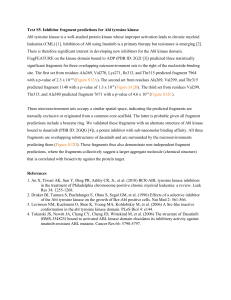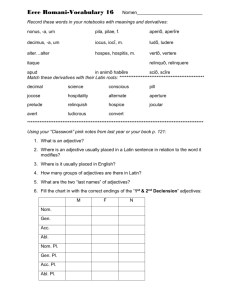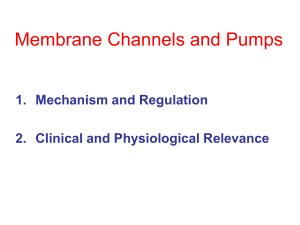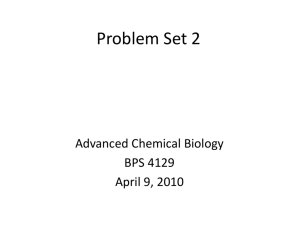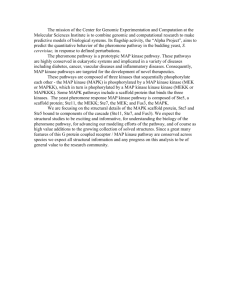A research-inspired laboratory sequence investigating acquired drug resistance Please share
advertisement
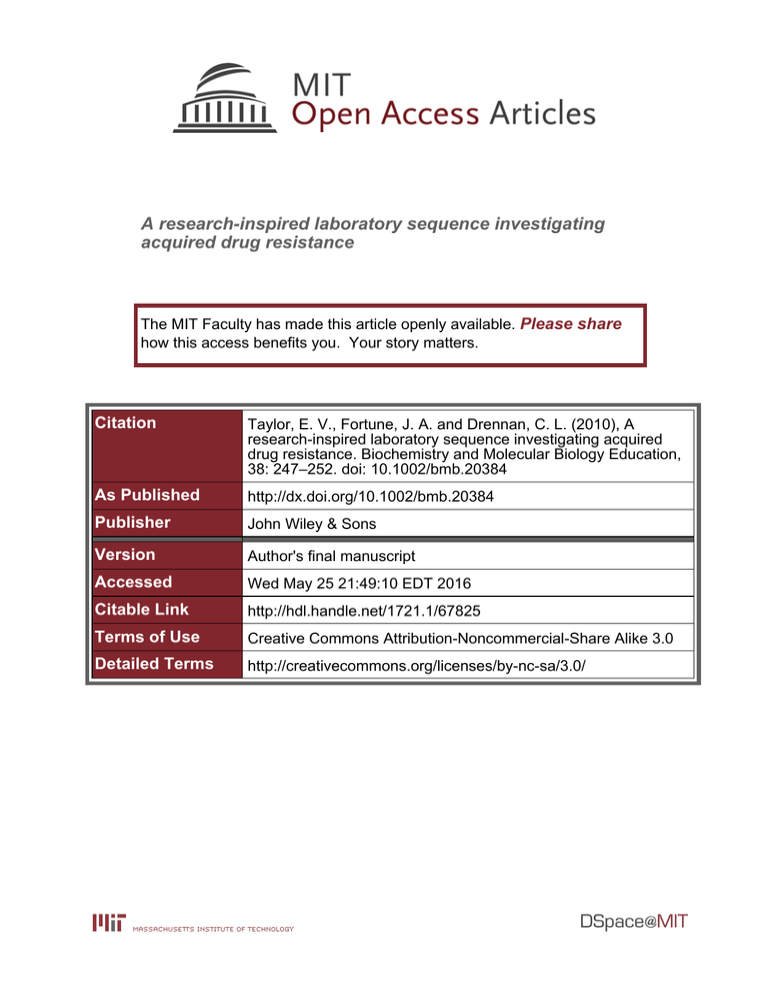
A research-inspired laboratory sequence investigating acquired drug resistance The MIT Faculty has made this article openly available. Please share how this access benefits you. Your story matters. Citation Taylor, E. V., Fortune, J. A. and Drennan, C. L. (2010), A research-inspired laboratory sequence investigating acquired drug resistance. Biochemistry and Molecular Biology Education, 38: 247–252. doi: 10.1002/bmb.20384 As Published http://dx.doi.org/10.1002/bmb.20384 Publisher John Wiley & Sons Version Author's final manuscript Accessed Wed May 25 21:49:10 EDT 2016 Citable Link http://hdl.handle.net/1721.1/67825 Terms of Use Creative Commons Attribution-Noncommercial-Share Alike 3.0 Detailed Terms http://creativecommons.org/licenses/by-nc-sa/3.0/ Laboratory Exercise A Research-Inspired Laboratory Sequence Investigating Acquired Drug-Resistance* Elizabeth Vogel Taylor‡,§, Jennifer A. Fortune§, Catherine L. Drennan§,¶,† From the Departments of §Chemistry and ¶Biology and †The Howard Hughes Medical Institute, Massachusetts Institute of Technology, Cambridge, MA 02139 Here we present a six-session laboratory exercise designed to introduce students to standard biochemical techniques in the context of investigating a high impact research topic, acquired resistance to the cancer drug Gleevec. Students express a Gleevec-resistant mutant of the Abelson (Abl) tyrosine kinase domain, the active domain of an oncogenic protein implicated in chronic myelogenous leukemia (CML), and investigate the kinase activity of wild type and mutant enzyme in the presence of two cancer drugs. Techniques covered include protein expression, purification, and gel analysis, kinase activity assays, and protein structure viewing. The exercises provide students with a hands-on understanding of the impact of biochemistry on human health, and demonstrate their potential as the next generation of investigators. Keywords: laboratory exercises, drug resistance, Gleevec, kinase, leukemia *This work was supported by the Howard Hughes Medical Institute (HHMI) through an HHMI Professors grant to Catherine L. Drennan. ‡ To whom correspondence should be addressed. Email: evogel@mit.edu Bcr-Abl is an oncogenic fusion protein that results from a chromosomal abnormality. The Bcr-Abl protein contains the tyrosine kinase domain of the Abl protein, but lacks the residues responsible for kinase auto-inhibition [1]. Bcr-Abl is therefore a constitutively active kinase, which means the default enzyme setting is “on”. The unregulated kinase activity of Bcr-Abl leads to chronic myelogenous leukemia (CML), a cancer that represents ~ 15% of all adult leukemias. High throughput screening and the “rational design” of small molecule inhibitors for Bcr-Abl culminated in the development of the drug Gleevec (also called imatinib or STI-576), which shows excellent efficacy against CML and was approved by the FDA in 2001 [2]. Gleevec has been called a magic bullet cure for cancer [3] and was the first example of a small molecule tyrosine kinase inhibitor to treat human disease. Gleevec inhibits Bcr-Abl by binding in the ATP-binding site and in a nearby hydrophobic pocket in the inactive conformation of the Abl kinase domain (Figure 1) [2, 4]. Unfortunately, a small percentage of CML patients do not respond to Gleevec treatment, and other patients who initially respond to treatment eventually develop Gleevec resistance. The majority of these cases can be linked to a single amino acid point mutation in the Abl kinase domain of Bcr-Abl, and over 50 different mutations that confer Gleevec resistance have been identified [1]. One of the more common mutations is H396P [5], which destabilizes the inactive (Gleevec-binding) form of the Abl kinase domain [1]. In this laboratory exercise students express and purify the H396P mutant of the Abl kinase domain (human Abl 1a residues 229-511). Students perform coupled phosphorylation assays to determine the specific activity and extent of inhibition of the wild type and H396P Abl kinase domain, respectively, in the presence of Gleevec and in the presence of Dasatinib, a second generation drug that was FDA approved in 2006 [6]. Students use a molecular viewing program to analyze the structural basis of inhibitor binding and mechanisms of drug resistance. Structure viewing also enables students to explore a second Gleevec-resistant Bcr-Abl mutant, the T315I mutant, which confers resistance in a completely different way than H396P and for which there are currently no approved drug inhibitors. The six sessions presented below are part of a ten-week laboratory course in the Department of Chemistry at the Massachusetts Institute of Technology, developed in 2007 as the biochemistry component of a curriculum redesign focused on “researchinspired” laboratory modules. The course, which includes a total of fifteen two- to fourhour laboratory sessions, is offered to sophomores, juniors and seniors who have completed a prerequisite biochemistry lecture course. Additional activities in the lab course, which are not described here, include DNA digestion and site directed mutagenesis, in which students design primers to create the DNA for another Gleevecresistant Abl-mutant of their choice. These additional exercises are interwoven with the sessions presented here. The complete 15-session laboratory course (MIT course 5.36), including six background and technique lectures, is freely available on the web via MIT OpenCourseWare [7]. LABORATORY STRUCTURE BY SESSION (~ four hours each) Sessions 1 and 2: Co-expression of the H396P Abl kinase domain with Yop phosphatase. Preparation of protein purification and kinase assay buffers. Session 3: Cell lysis and purification of the H396P Abl kinase domain. Session 4: SDS-PAGE gel analysis of the purified H396P Abl kinase domain, protein concentration, and quantification using a protein concentration assay based on the Bradford method. Session 5: Kinase activity assays of the (commercially-available) wild type and H396P mutant Abl kinase domains in the presence and absence of small molecule Abl inhibitors (and approved CML cancer drugs) Gleevec and Dasatinib. Session 6: Analysis of the mechanism of Abl inhibition and the effect of other Abl mutants of inhibitor binding using a protein structure-viewing program. Detailed student and instructor manuals and supply / equipment lists are provided in supplemental materials. Co-expression of the H396P Abl kinase domain with Yop phosphatase (Sessions 1 and 2) Until recently, overexpression of the Abl kinase domain was not practical for a basic undergraduate laboratory. Kinase activity can be toxic to bacterial cells, and thus 2 there were no reported methods for isolating mg quantities of the Abl kinase domain from E. coli. Fortunately, in 2005, researchers overcame this limitation by co-expression of the kinase domain with a protein phosphatase, YopH [8]. The H396P Abl mutant expression and purification used here is modified from published protocols to fit into four-hour laboratory sessions. In lab Session 1, students are provided with BL21-DE3 expression cells co-transformed with two expression vectors; a kanamycin-resistant vector encoding a hexahistidine-tagged H396P Abl kinase domain and a streptomycin-resistant vector encoding the YopH phosphatase. Students prepare LB media with both kan and strep antibiotics with an emphasis on establishing sterile techniques. Students grow 20-mL overnight starter cultures, then inoculate 500 mL of LB/kan/strep and grow the culture to midlog phase at 37 °C (approximately 3 hours). The culture is then transferred to an unheated shaker, induced with 0.2 mM IPTG and grown at room temperature overnight. Cells are harvested by centrifugation, and the resulting cell pellet is frozen at -20 °C until Session 3. Preparation of protein purification and kinase assay buffers (Sessions 1 and 2) An essential component of any biochemistry education is a proficiency in calculating and preparing buffers. During Sessions 1 and 2, students calculate the needed quantities of components, and prepare and adjust the pH of buffers used in Sessions 3 through 5. These buffers include Ni-NTA binding, washing, and eluting buffers, TBS, gel pouring and electrophoresis buffers, and Tris-based buffers for running the kinase activity assays. Students also prepare a stock solution of BSA, which is used in Session 4 for protein quantification. Affinity-tag purification of the H396P Abl kinase domain (Session 3) The H396P Abl kinase domain is isolated from cellular proteins and the YopH phosphatase via its amino-terminal hexahistidine tag. Ni-NTA resin is one of the least expensive affinity purification resins and can be regenerated and reused, making hexahistidine affinity purification an economic choice for an undergraduate lab. For cell lysis, the pellet is thawed, and then resuspended in 20 mL of B-PER detergent in the presence of a protease inhibitor cocktail. The suspension is agitated for 10 min at 4 °C and then subjected to centrifugation. The soluble fraction is incubated with 1 mL of NiNTA resin in ~ 50 mL of binding buffer (50 mM Tris, 300 mM NaCl, pH 7.8) for 20 minutes, and the resin slurry is poured into a plastic column and then washed with 30 mL of washing buffer (binding buffer plus 30 mM imidazole). The protein is eluted with 1.2 mL aliquots of elution buffer (binding buffer plus 200 mM imidazole). Students measure the absorbance of each fraction at 280 nm, and combine the fractions with the highest absorbance, indicating the highest protein concentrations. These fractions are dialyzed into TBS buffer (200 mM Tris, 1.4 M NaCl, pH 7.5) to remove the imidazole. SDS-PAGE gel analysis of H396P Abl, and protein concentration and quantification Session 4 Students pour an SDS-PAGE gel and prepare protein elution samples for gel analysis. The gel is run at 200 V for one hour, stained with Coomasie blue dye for 10 to 3 25 minutes, and then destained. Students take a picture of their gel for their lab report, as shown in Figure 2. The Abl kinase domain appears as a band at approximately 33 kDa. YopH phosphatase sticks somewhat to Ni-NTA resin despite having no hexahistidine tag, so a band for YopH can be seen in concentrated gel fractions. Published protocols use anion exchange to achieve higher Abl purity, but the single Ni-NTA purification is suitable for the needs of this lab. Students concentrate the protein to approximately 0.5 mL using centrifugal concentrators and use a quantification assay based on the Bradford method to determine the protein concentration of the H396P Abl kinase domain after purification and dialysis. Final protein concentrations vary widely in the hands of students, ranging from 2 to 20 mg/mL. Protein is stored at 4 °C until Session 5. Kinase activity assays of the wild type and H396P mutant kinase domains Session 5 Students perform coupled phosphorylation assays to determine the specific activity of the (commercially available) wild type Abl kinase domain and the (studentexpressed) H396P mutant kinase domain 1) in the absence of an inhibitor 2) in the presence of the drug Gleevec, and 3) in the presence of the drug Dasatinib. The kinase activity of the wild type and H396P Abl kinase domains is monitored via an assay that “couples” the kinase-mediated conversion of ATP to ADP with the oxidation of NADH to NAD+ (Figure 3), which can be detected by a decrease in NADH absorbance at 340 nm. The assay is ideal for an undergraduate setting, since, unlike other common strategies for monitoring kinase activity, it does not require radioactive material or a fluorometer. For each inhibitor-free assay, a 120 µL reaction is set up in an eppendorf tube with 3 µL (0.03 µg) of wild type or 10 µL (2 to 20 µg) of mutant Abl kinase domain, 100 mM Tris, pH 7.5, 10 mM MgCl2, 2 mM ATP, 155 µM NADH, 1 mM PEP, 74 U/mL pyruvate kinase (PK), and 104 U/mL lactate dehyrogenase (LDH). The solution is gently mixed with tapping, and then transferred to a quartz cuvette with a 100-µL window. To determine background ATPase activity, which is later subtracted from the slope of the reaction, the absorbance at 340 nm is recorded for two to four minutes. The substrate peptide (EAIYAAPFAKKK) is then added to a final concentration of 1 mM to start the reaction, and the decrease in absorbance at 340 nm is monitored for five to ten minutes. For reactions in the presence of an inhibitor, 1 µM of Gleevec or Dasatinib is added to the reaction mixture. Note that the reactions can be run by experienced hands at a final volume of 100 µL, but that in the hands of students, a 120 µL reaction leaves room for imperfect transfer and results in far more consistent measurements with a 100 µL cuvette. Normalized student assay results for the six reactions (wild-type Abl with no inhibitor, wild type Abl with Gleevec, wild type Abl with Dasatinib, H396P Abl with no inhibitor, H396P Abl with Gleevec, and H396P Abl with Dasatinib) are shown in Figure 4. The corresponding specific activities in the absence and presence of inhibitors for the wild type and the H396P mutant Abl kinase domains are presented in Table 1. Detailed instructions for calculating specific activities are provided in the supplemental materials on pg. 18 of the student manual. In the discussion section of their laboratory reports, students interpret the assay findings, which indicate that 1 µM Gleevec inhibits the wild type enzyme, with a 66% decrease in specific activity, but does not significantly inhibit the H396P mutant, with only a 17% decrease in specific activity (percentages calculated 4 from the student data shown). In contrast, 1 µM Dasatinib completely or nearly completely inhibits both the wild type and the H396P mutant Abl kinase domains. An important note on data analysis: In this laboratory students compare the specific activity in the absence and presence of inhibitors for both the wild type and the H396P mutant Abl kinase domains to determine the effectiveness of each inhibitor on the wild type and the mutant protein. It is NOT valid to compare absolute values of specific activities between the wt and mutant. The activity of the mutant Abl kinase domain is significantly lower than the commercially available wild type protein because of differences in purity, the presence of the hexahistidine tag on the mutant, and the preactivation by phosphorylation of the commercial wild type enzyme. In addition, a 2006 study demonstrated that the H396P mutation itself results in decreased in vitro kinase activity compared to the wild type [9]. Protein Structure Viewing Session 6 In the final session students complete a structure viewing exercise using the (free) molecular viewing program PyMol [10] to analyze the structural basis of Abl inhibition by Gleevec and Dasatinib. The structure viewing exercise is available in the supplemental materials (pages 21-27 of the student manual) and provides basic PyMol manipulation instructions and series of questions that lead students to explore Abl structures (PBD IDs: 1IEP, 2GQG, 2F4J), compare binding mechanisms of Gleevec and Dasatinib, and make conclusions about modes of drug-resistance. A general understanding of kinase structure is helpful for the more complex questions on the worksheet. A one-page published primer on kinase inhibition provides a succinct overview [11], and the lecture slides and notes on conserved and variable features of kinase domains, which can be found as Lecture 4 on the course 5.36 webpage [7], provide a more in-depth lesson. A number of extensions can be added to facilitate more student design into this laboratory experience. For example, for the MIT course in which these exercises are included, students select a second Abl mutant of their choice from the over 50 point mutations implicated in CML, and they design primers to create the DNA for that mutant. Students are asked to justify their mutant selection based on information from an assigned review article [1] and/or published crystal structures. Another opportunity for student design is in the kinase assays. Extensions could include planning control experiments to test assay assumptions, using other kinases to probe drug selectivity, or designing experiments with additional inhibitors. Depending on course resources and time constraints, these activities could be carried out in the laboratory or simply written up by the students as proposals within their laboratory reports. Laboratory report Student laboratory reports include: • an introduction, which briefly describes the purpose of the research and provides background information based on an assigned review paper on Bcr-Abl inhibitors [1] • a methods section describing the lab work in a concise format 5 experimental results and data analysis, including a picture of the protein gel, BSA assay results, graphs of all kinase assays, a table including the slope, enzyme amount, and specific activity for each kinase assay (such as Table 1), and a sample calculation of specific activity • a discussion section. In the discussion, students compare specific activity results to make conclusions about how effective each drug is in inhibiting the wild type and the H396P mutant Abl kinase domains. Students are encouraged to incorporate information from the crystal structures viewed in Session 6 to explain their data. For example, the lab data shows that Dasatinib effectively inhibits the H396P mutant, but that Gleevec does not. Through the structure viewing exercise students determine that Dasatinib binds the active form of Abl, while Gleevec binds the inactive form. Since the H396P mutant destabilizes the inactive form of Abl, the crystal structures support the observed data. Students also submit the completed structure viewing worksheet in the appendix of their laboratory report. • Student-reported gains Multi-session laboratory exercises with a unifying research problem enable students to develop and apply basic research skills in an inspiring context, as demonstrated in a number of project-based laboratories in colleges across the country [12-15]. Following implementation of the Gleevec lab exercises at MIT in the spring semesters of 2008 and 2009 as part of a biochemistry laboratory course, students reported significant gains in the following skills: protein expression and purification, enzymatic assays, and protein structure viewing, reporting a proficiency (on a 7-point scale) increase from 3.0 prior to the course to 5.3 following the course, averaged over all skills (Table 2, N = 44, a 74% response rate). The students’ self reported gains were qualitatively confirmed by TA and instructor observations in the lab and based on the high quality of the student laboratory reports. Students also responded with extremely high ratings of agreement with the following additional statements on the 2009 survey (N = 16, a 64% response rate): “As a result [of this lab] I have a better understanding of how chemistry research can have a direct impact of human health and medicine” (6.2/7) and “I found that learning biochemistry techniques in the context of an overarching research project made learning more interesting” (6.0/7). Students disagreed with the statement that “I would have preferred to have each laboratory technique introduced separately, instead of as part of an ongoing research project” (2.6/7). In addition, the 2009 course rating on standard MIT course evaluations was a 6.0/7 (N = 25, a 100% response rate) an excellent rating for any course, and an extremely high rating for a lab course. For reference, the corresponding lab had an average rating of 4.2 out of 7 over the five years prior to being replaced by our course. Taken together, the survey responses suggest that students made significant gains in laboratory skills during the course and that the topic of investigating Gleevec resistance provides an exciting format for learning lab techniques and makes a clear connection between research and human health. Acknowledgements: We thank the Kuriyan lab and Marcus Seeliger for ABL and YOPH plasmids and for insight on modifying expression and purification procedures for an undergraduate lab. We thank Alice Ting, the MIT course 5.36 and 5.52 teaching 6 assistants, and Mariusz Twardowski for helpful discussions and for troubleshooting the lab procedures. References [1] E. Weisberg, P. W. Manley, S. W. Cowan-Jacob, A. Hochhaus, J. D. Griffin (2007) Second generation inhibitors of BCR-ABL for the treatment of imatinib-resistant chronic myeloid leukemia, Nat. Rev. Cancer 7, 345-356. [2] T. Schindler, W. Bornman, P. Pellicena, W. T. Miller, B. Clarkson, J. Kuriyan (2000) Structural mechanism for STI-576 inhibition of abelson tyrosine kinase, Science 289(5486), 1938-1942. [3] M. D. Lemonick (2001) New Hope for Cancer, Time, May 30th. [4] B. Nagar, W. Bornmann, P. Pellicena, T. Schindler, D. R. Veach, W. T. Miller, B. Clarkson, J. Kuriyan (2002) Crystal Structures of the Kinase Domain of c-Abl in Complex with the Small Molecule Inhibitors PD173955 and Imatinib, Cancer Res. 62, 4236-4243. [5] J. F. Apperley (2007) Mechanisms of resistance to imatinib in chronic myeloid leukaemia, Lancet Oncol. 8, 1018-1029. [6] J. S. Tokarski et al. (2006) The Structure of Dasatinib (BMS-354825) Bound to Activated ABL Kinase Domain Elucidates Its Inhibitory Activity against ImatinibResistant ABL Mutants, Cancer Res. 66, 5790-5797. [7] MIT OpenCourseWare, 5.36 Biochemistry Laboratory: http://ocw.mit.edu/OcwWeb/Chemistry/5-36Spring-2009/CourseHome/index.htm [8] M. A. Seeliger, et. al. (2005) High yield bacterial expression of active c-Abl and c-Src tyrosine kinases, Protein Sci. 14, 3135-3139. [9] I. J. Griswold et. al. (2006) Kinase domain mutants of Bcr-Abl exhibit altered transformation potency, kinase activity, and substrate utilization, irrespective of sensitivity to imatinib, Mol. Cell. Biol. 26(16), 6082-6093. [10] PyMol Molecular Viewer- Homepage: http://pymol.org/ [11] J. Zhang, N. Gray, J. Kotz (2009) Primer: Kinase inhibitors, Nat. Chem. Biol. 5(10). [12] S. G. Cessna, T. L. S. Kishbaugh, D. G. Neufeld, G. A. Cessna (2009) A Multiweek Problem-Based Laboratory Project Using Phytoremediation To Remove Copper from Soil, J. Chem. Ed. 86(6), 726-729. [13] K. A. J. Arkus, J. M. Jez (2008) An Integrated Protein Chemistry Laboratory, Biochem. Mol. Bio. Educ. 36(2), 125-128. [14] N. Briese, H. V. Jakubowski (2007) A Project-based Laboratory Promoting the Understanding and Uses of Fluorescence Spectroscopy in the Study of Biomolecular Structures and Interactions, Biochem. Mol. Bio. Educ. 35(4), 272-279. [15] A. J. Draper (2004) Integrating Project-Based Service Learning into an Advanced Environmental Chemistry Course, J. Chem. Ed. 81(2), 221-224. 7 Table 1. Specific activities and the experimental data for calculating specific activities for each of the student-run 120 µL reactions shown in Figure 4. See supplemental information (page 18 of the student manual) for specific activity calculation details. wt Abl, no inhibitor wt Abl, 1 µM Gleevec wt Abl, 1 µM Dasatinib H396P Abl, no inhibitor H396P Abl, 1 µM Gleevec H396P Abl, 1 µM Dasatinib ⏐slope ⏐ R2 background ⏐slope ⏐ Final ⏐slope ⏐ 0.0052 0.0027 0.0002 0.0089 0.0078 0.0017 0.948 0.914 0.064 0.983 0.988 0.745 0.0003 0.001 0.001 0.0021 0.0021 0.0013 0.0049 0.0017 0.0068 0.0057 0.0004 Enzyme amount (µg) 0.030 0.030 0.030 3.8 3.8 3.8 specific activity* (U/mg) 3.2 1.1 >0 0.035 0.029 0.002 Table 2. Student-reported proficiency with the basic biochemistry techniques prior to and following the completion of the lab exercises. All items are on a 7-point scale from 1 (not at all proficient) to 7 (very proficient). Reported means are aggregated across student responses from 2008 and 2009. N = 44 (out of 60 students total: a 73% response rate) Prior to lab Following lab completion Protein expression and purification 2.9 5.3 Enzymatic assays 2.9 5.3 Protein structure viewing 3.3 5.4 Fig. 1. Gleevec (green) bound to the inactive conformation of the Abl kinase domain (purple). PDB ID: 1IEP [4]. Fig. 2. Student SDS-PAGE gel of H396P Abl kinase domain. Lane 1: molecular weight ladder, lane 2: pre-induction sample, lane 3: crude protein solution, lanes 4 – 10: elution samples. 8 Fig. 3. Coupled phosphorylation assay. Through two additional enzymatic reactions (catalyzed by pyruvate kinase (PK) and lactate dehydrogenase (LDH)) the Abl kinase activity is coupled to the conversion of NADH to NAD+, which can be monitored by a decrease in NADH absorbance at 340 nm. Fig. 4. Results of coupled phosphorylation assays (student data). Change in absorption over time normalized to an absorbance of 1.0 at t = 0 for A) the wild type Abl kinase domain and B) the H396 mutant Abl kinase domain in the presence of no inhibitors (blue diamonds), 1 µM Gleevec (green squares), and 1 µM Dasatinib (purple triangles). Fig. 1. Gleevec (green) bound to the inactive conformation of the Abl kinase domain (purple). Asp381, Gly382 and Phe383 are shown in ball-and-stick form to highlight the “DGF-out” conformation, characteristic of the inactive form of kinases. Thr315, a residue explored in the structure viewing exercise in Session 6, is also shown in ball and stick form. PDB ID: 1IEP [4]. 9
